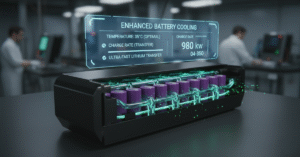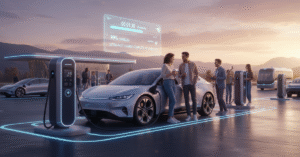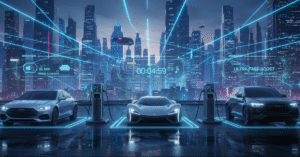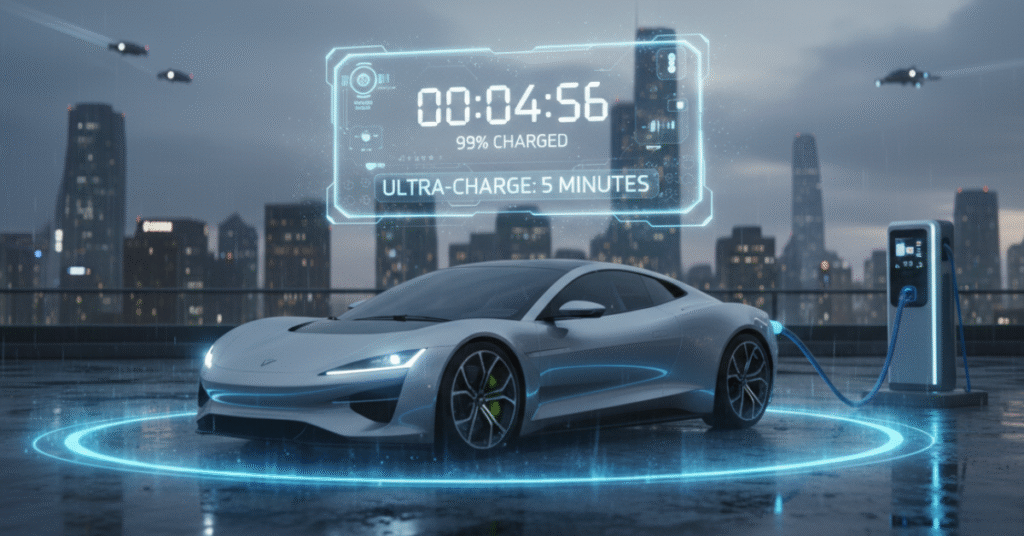5 minute EV charge time is no longer a futuristic dream but a rapidly approaching reality. This innovation is set to completely revolutionize the electric vehicle (EV) industry globally.
For years, the biggest hurdle stopping people from switching to electric cars has been “range anxiety.” More importantly, it has been the long wait times at charging stations. We all know that pulling into a gas station takes just two minutes. However, a rapid EV charge often takes 30 to 45 minutes, making it a major inconvenience. What if a groundbreaking new technology could eliminate this problem forever?
The Breakthrough: What Makes This Ultra-Fast Charging Possible?

The secret to achieving a significantly reduced charging time lies in a radical shift in battery technology and thermal management. It is not just about the charger itself.
Traditional EV batteries struggle with ultra-high charging rates because of two main issues: overheating and lithium plating. Lithium plating is essentially damage to the battery cells.
The Core Innovation: Enhanced Battery Cooling
The key improvement is the development of advanced liquid-cooling systems. Many existing articles fail to emphasize the cooling system’s importance.
These systems can precisely manage the immense heat generated when electricity is pumped into the battery. This charging often happens at extremely high power, sometimes over 500 kW! Companies are using innovative materials and designs, like cooling channels running directly through the battery pack. This ensures the cells remain at optimal temperatures. This prevents degradation and allows for safe, ultra-rapid charging. This advancement is fundamental to realizing the dream of a 5 minute EV charge time.
Chemical Evolution: Silicon Anodes
Another crucial factor is the use of new materials in battery construction. While most commercial EVs rely on graphite anodes, some companies pioneering the ultra-fast charging are utilizing silicon-based anodes.
Silicon has a much higher energy density. This allows batteries to absorb lithium ions much faster than before. This chemical change, combined with smart battery management software, enables the battery to accept and store power at an unprecedented speed without being damaged. This breakthrough pushes us closer to true petrol-pump convenience.
My Experience and the Real-World Impact

As someone who closely follows the automotive industry, I can tell you that this shift is profound and game-changing. Think about your last road trip. If you had to stop for a 30-minute charge, you likely spent that time scrolling on your phone or having a forced coffee break.
This new technology means that charging becomes virtually indistinguishable from filling up petrol. It will be a brief, five-minute pause. This convenience has several major benefits:
- Eliminating Range Anxiety: The psychological barrier of long waits disappears completely, which will encourage faster EV adoption globally.
- Infrastructure Shift: Charging station design will change dramatically, requiring more advanced, high-power grids and more specialized ultra-rapid units.
- Accessibility: EVs will become a viable choice for everyone, especially those who rely on fast charging in high-density urban areas or on long-haul routes.
Who is Leading the Race for the Fastest Charge?

Several major players are competing fiercely in this ultra-fast charging space. The most current information points to a few key innovators who have successfully demonstrated this capability.
- Chinese Manufacturers: Some have already launched high-end models using advanced 800-volt architectures. These cars can add hundreds of miles of range in just 10 to 15 minutes. This is the closest current commercial reality to the 5 minute EV charge time goal, showing the technology is viable.
- Pioneering Startups: Certain research companies focused on battery chemistry have published lab results. They show a 10% to 80% charge in less than five minutes using cutting-edge silicon-anode technology. While these are currently prototypes, they undeniably prove the concept works and drive the industry forward. This new development confirms that the goal of a 5 minute EV charge time is technologically achievable.
Challenges Remaining on the Road Ahead
While the breakthrough is thrilling, we must address the remaining challenges to provide a truly complete and truthful article:
- Grid Readiness: Can our current electricity grids handle multiple 500+ kW chargers running simultaneously in one location? Significant infrastructure upgrades are needed globally to support the mass adoption of such powerful chargers.
- Cost: The advanced liquid-cooling systems and the new battery chemistries (like silicon anodes) are currently more expensive than standard components. This could potentially drive up the initial cost of the EV, although these costs are expected to drop significantly with scale and production volume.
- Standardization: The industry needs to agree on a universal high-power charging standard. This is crucial to ensure that all EVs can equally benefit from this technology, preventing fragmentation and compatibility issues.
Conclusion: The End of the Charging Wait?
The journey to an all-electric future hinges on convenience, and the 5 minute EV charge time innovation provides exactly that. This fact is not just a technological advancement. It is a massive shift in user experience that validates the EV as the ultimate transport solution. We are truly standing at the brink of a new era where waiting for your car to charge will become a distant memory. This development will undoubtedly accelerate the global adoption of electric vehicles faster than ever before.

